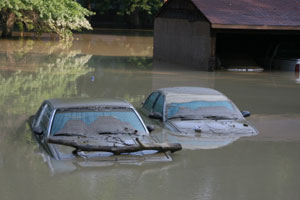
Submersion in water due to storms, swollen rivers or any sudden flooding can cause extensive damage to vehicles and must be disclosed to potential buyers prior to a sale.
When most people think of vehicles being damaged by floodwater, they think of the cars and trucks that get flooded in Gulf States each year by hurricanes and tropical storms. Annually, tens of thousands to hundreds of thousands of vehicles are damaged by flooding and it is estimated that in the year 2001 alone, more than 600,000 vehicles were damaged by hurricanes and tropical storms. While most of these flooded vehicles end up having their titles marked as salvaged, many uninsured vehicles end up slipping through the cracks and are deceptively reconditioned to look as though they were never flooded. These vehicles can then be sold to unsuspecting buyers who might not know how to spot vehicle flood damage.
In California, where flooding is a rarity, many car buyers will never even question whether the used vehicle they are considering to buy may have had flood damage. This creates a perfect opportunity for dishonest sellers to make large profits from the sale of flood damaged vehicles. While flooding may seem uncommon, it can happen anywhere and at any time. Storms in the desert can quickly turn to flash floods washing cars away, rivers can flood over their banks, a flooded street with deep water may deceivingly seem shallow enough to drive on, a pipe in an underground garage may burst or a vehicle may accidentally be backed underwater from a boat launch. The amount of flood damage to a vehicle varies depending on whether the flooding involved fresh water, salt water or muddy water as well as how much of the vehicle was submerged. Vehicle flood damage is affected by what kind of treatment was given to the vehicle and how much time passed between the vehicle’s submersion and the treatment.
Vehicle Flood Damage may not always be visible. The computer systems and electrical components that are in vehicles are connected by a vast series of wires that run throughout the entire vehicle. After a vehicle has been submerged in water for any length of time, moisture gets trapped in the vehicle that, over time, will slowly rust the wiring causing various components to malfunction or fail as the electrical currents erroneously ground when they encounter rust. This failure could seriously rick the safety of anyone in the vehicle as it is unpredictable and could affect any system in the vehicle including but not limited to the fuel system, steering, brakes and airbags. This complex series of wires is very difficult and expensive to replace so often it will be left to possibly fail by simply covered the wires with new upholstery or carpet.
In addition to the computer systems, electrical components and wiring, rubber seals and o-rings may swell and leak, sensors may fail and the transmission could start to deteriorate. Flood damaged vehicles are ticking time bombs.
Check For Car Flood Damage
Below are a few signs to look for when considering a used vehicle that may help protect you from purchasing a flood damaged car, truck or vehicle.
- Thoroughly Inspect The Vehicle For Moisture
- Look For Moisture In The Headlights, Taillights And Turn Signal
- Look For Moisture In The Dome Light, Interior Lights And Instrument Cluster
- Unwind The Seat-Belt Retractors
- Check Under The Seats For Dampness Or Sweating
- Inspect The Vehicle For Dirt, Silt And Rust
- Center Console
- Under The Dashboard
- Glove Compartment
- Trunk
- Under The Hood
- Test Each Of The Vehicle’s Electrical Systems Several Times
- Audio System and Speakers
- Clock
- Heating And Air Conditioning
- Instrument Gauges
- Interior And Exterior Lights
- Turn Signals
- Warning Lights
- Windshield Wipers
- Smell For Musty Odors Like Mildew
- Check The Carpeting Under The Floor Mats
- Check The Upholstery (Both Leather and Cloth)
- Check The Trunk Liner
- Check The Air Conditioning Vents
- Check The Upholstery, Headliner And Carpet
- Look For Discolored Or Mismatched Fabric Or Carpeting
- Look For Loose Carpeting That May Have Been Replaced
- Look For Water Damage Stains
- Test Drive The Vehicle
- Turn Vehicle On And Off Several Times
- Drive Vehicle As Long As Possible On City Streets And On The Highway
- Retest As Many Electrical Systems As Possible When Test Driving The Vehicle
- Review The Vehicle’s History Report And Title
- Check If Vehicle Has A Salvage Title.
- Check If Vehicle Has A Flood Title
- Check To See If An Insurance Company Was Ever An Owner
- Check To See If Vehicle Was Transferred From A Flood Prone State
- Have A Mechanic Inspect The Vehicle Prior To The Purchase
- Make Sure The Mechanic Has Experience Looking For Flood Damage
- Have The Mechanic Re-Check The List Above
A problem with one or even some of the items above may not mean that the vehicle has been submerged in water, but should make you aware and more cautious of the of the possibility. When in doubt, walk away. The cost and time spent dealing with corroding wires, failing systems, faulty computers and the increased chance of getting into a serious accident makes flood damaged cars, trucks, SUVs and other vehicles simply not worth the initial savings, let alone the risk!
If you suspect that you may have bought a vehicle that was submerged in water and then sold to you without disclosure, then you give us a call at (888) 536-6628 or fill out our FREE Vehicle Evaluation Form and one of our CA Dealer Fraud Attorneys will review your case to discuss what legal options are available to you.
 review my case
review my case